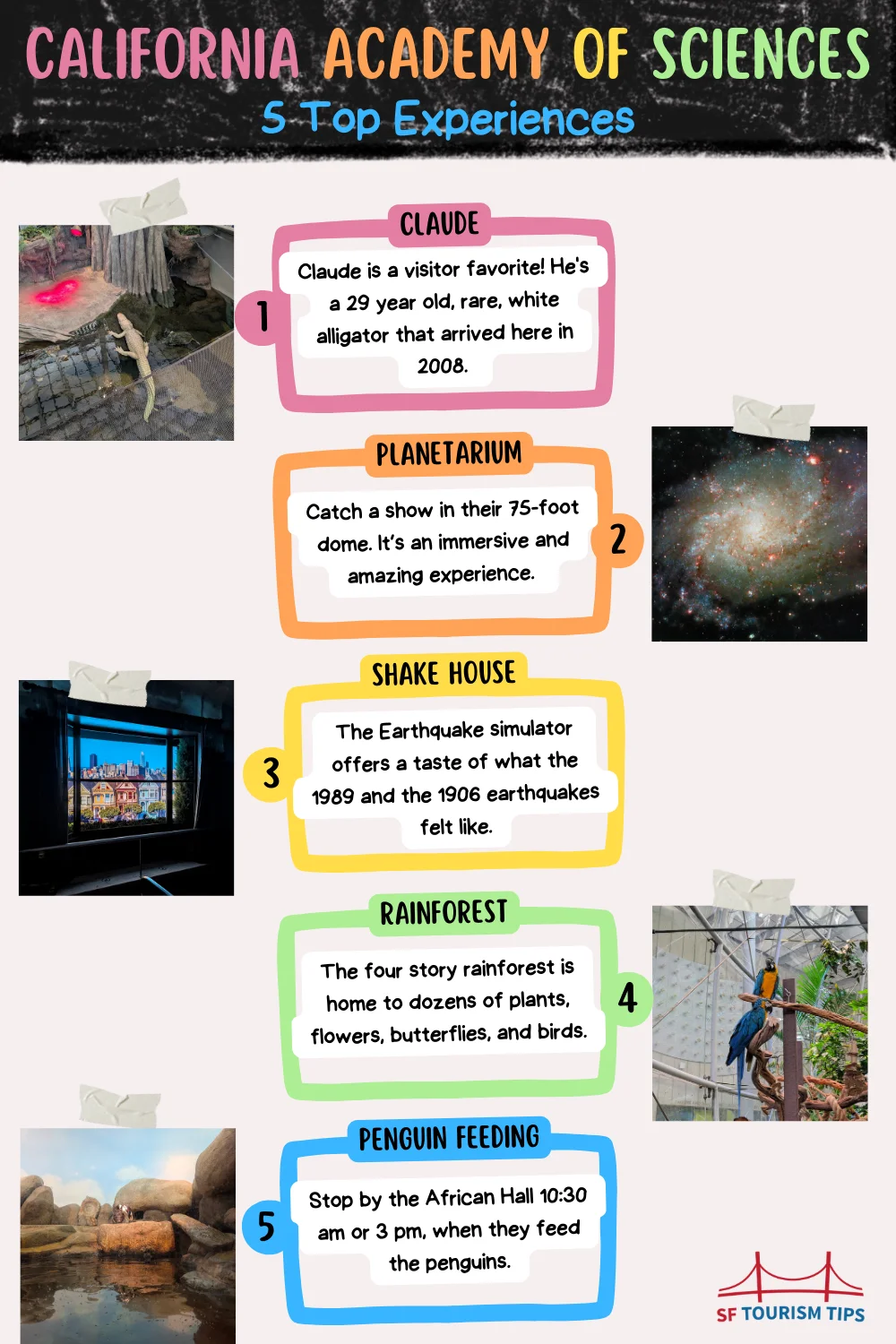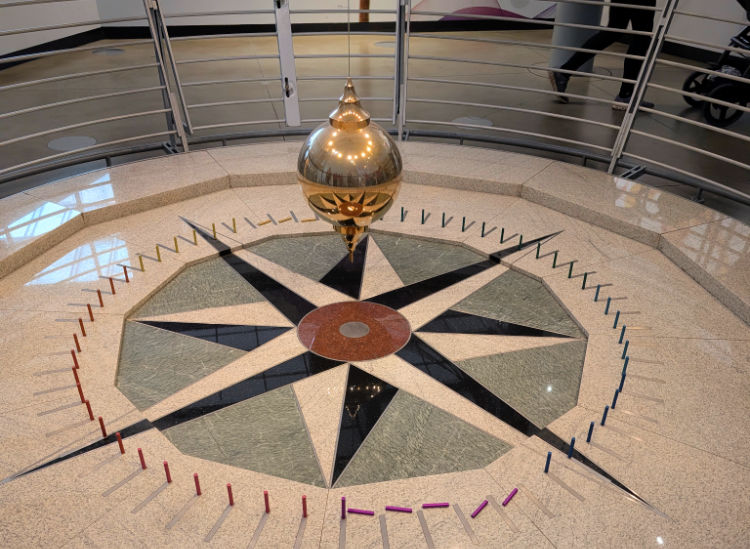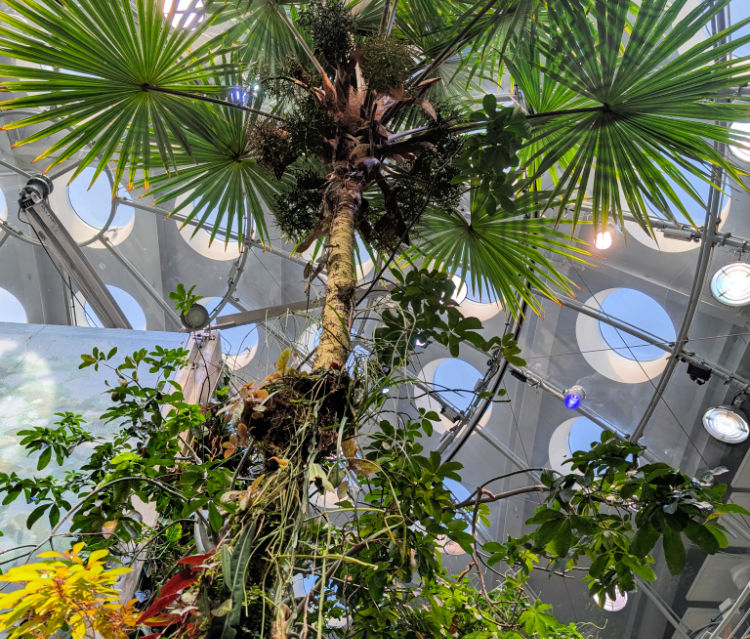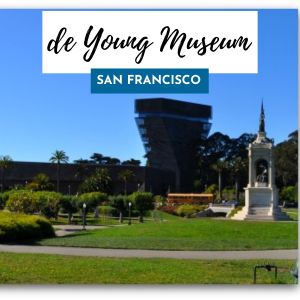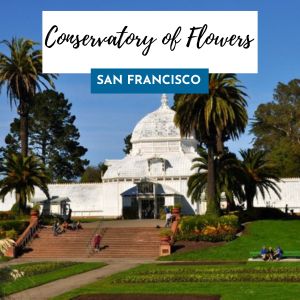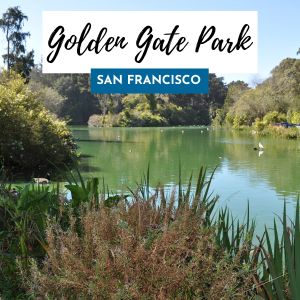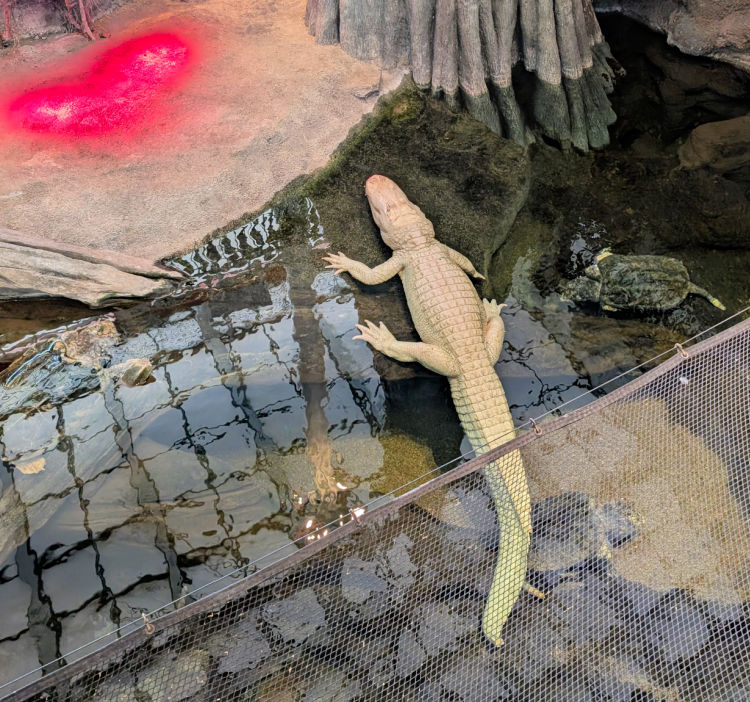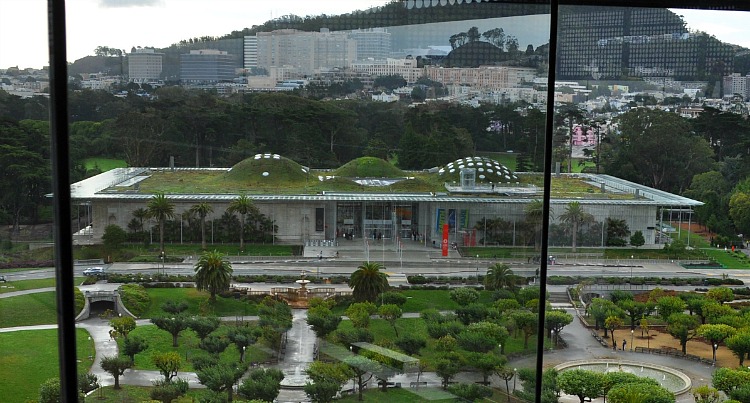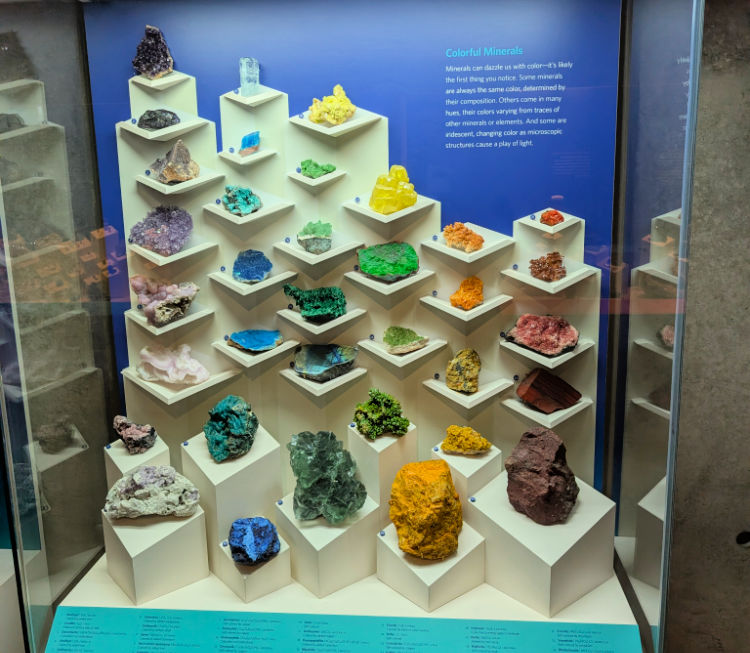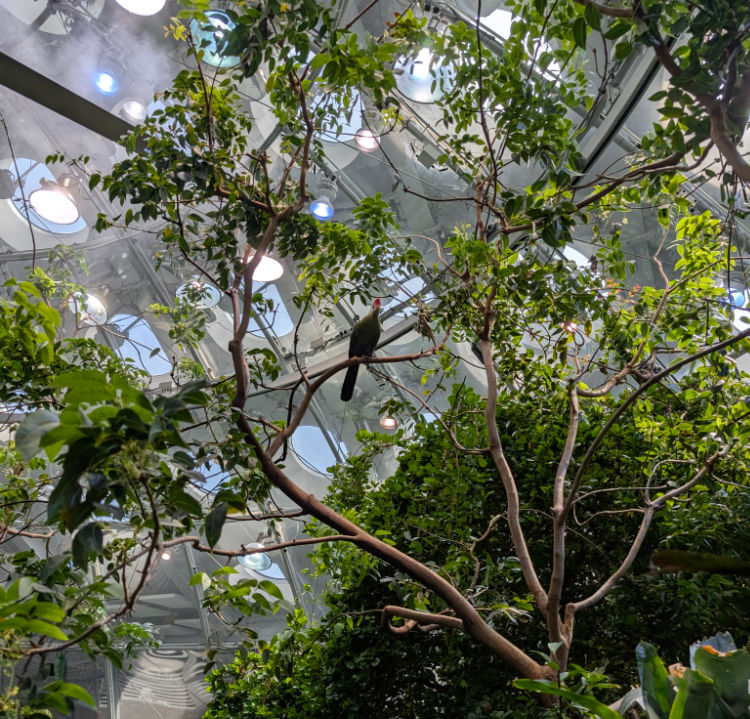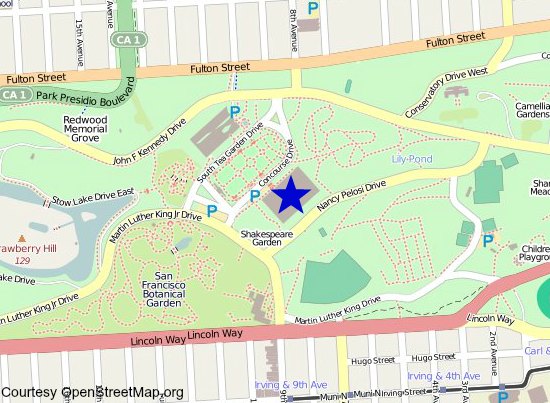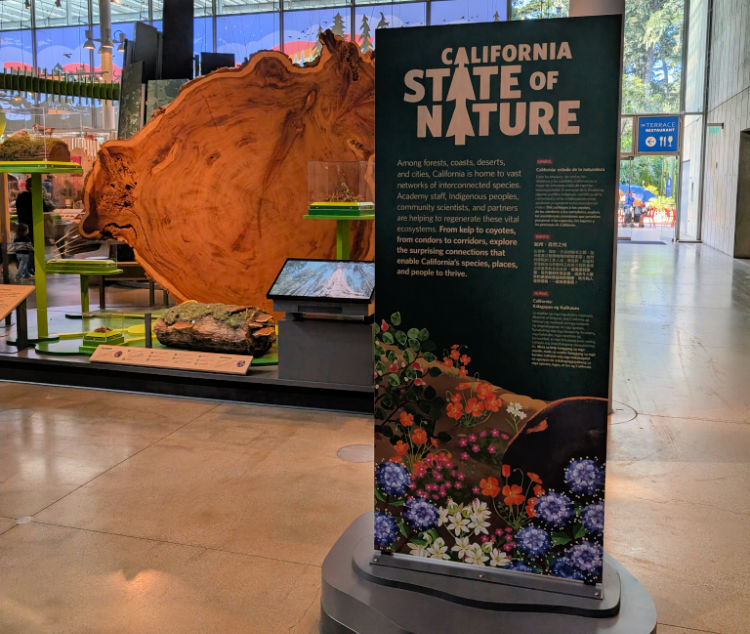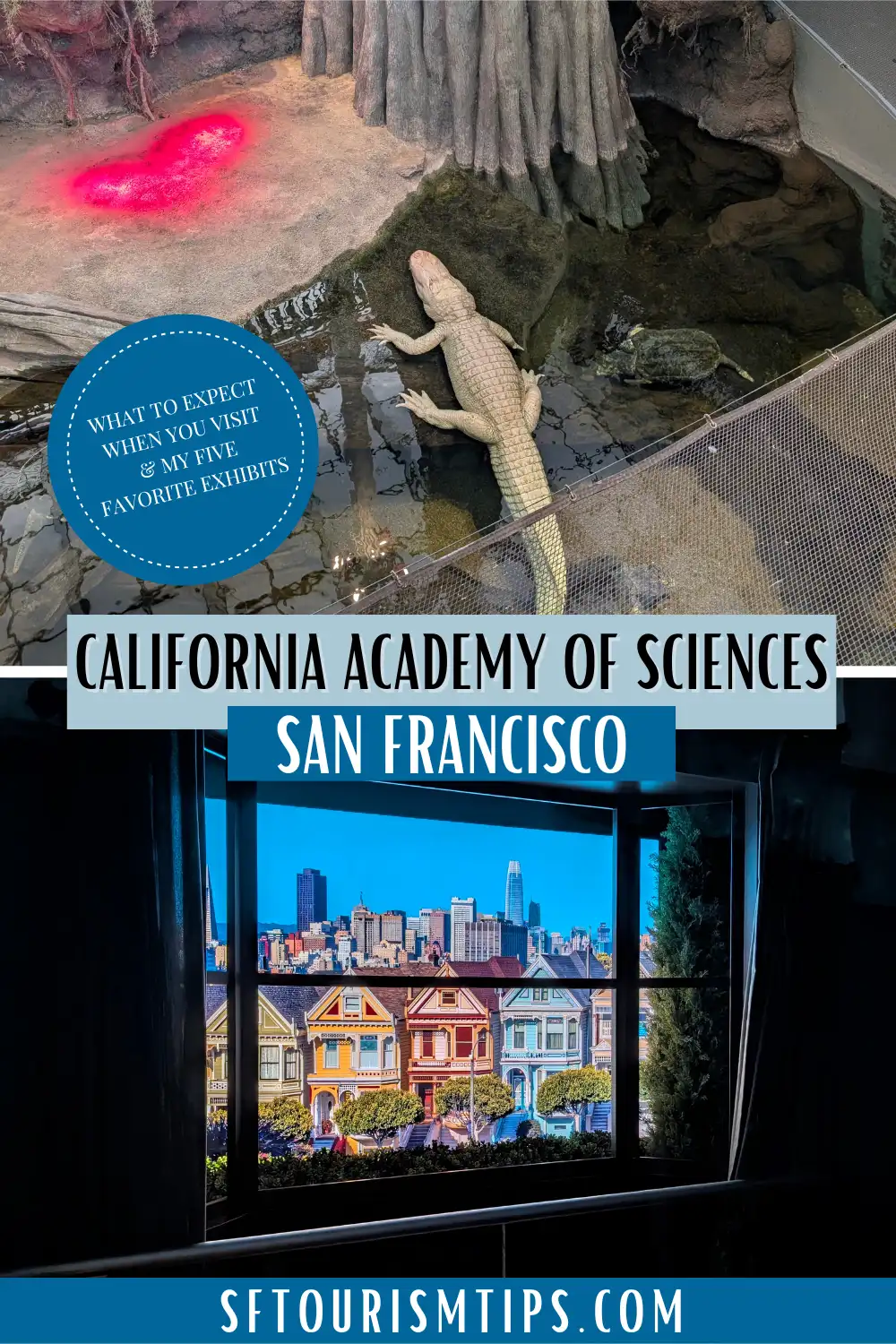SIGN UP FOR MY EMAIL TO RECEIVE YOUR FREE SAN FRANCISCO PLANNING GUIDE.
What to Expect on Your Visit to the California Academy of Sciences
By: Jill Loeffler • Updated: March 26, 2024 • Published: October 19, 2012
The California Academy of Sciences is one of our most visited San Francisco museums.
Set in Golden Gate Park, this popular science museum is home to the Morrison Planetarium, one of the world's largest all-digital planetariums; the Osher Rainforest, a four-story beauty; the Steinhart Aquarium; and the Kimball Natural History Museum.
I recently refreshed this page with up-to-date information after my visit in March 2025.
I absolutely love this museum and visit as often as I can. There is so much to see and do here, especially for kids!
Jill's Five Reason's to Visit
I could go on and on about the amazing things to see and do at the California Academy of Sciences, but here are five of my favorites that you will enjoy too! All are included with your entrance ticket.
- Claude, the White Alligator: Claude is a visitor favorite! He's a 29-year-old, rare, white alligator that arrived here in 2008. He doesn't move around much most days but draws in a huge crowd every day!
- Planetarium Shows: Catching a show in their 75-foot dome is an immersive and amazing experience. They usually offer two to three shows a day on a first-come, first-served basis. I recommend scanning the QR code in the lobby when you first arrive to secure your tickets before they are gone!
- The Shake House: Have you ever wondered what it is like to be in an earthquake? Well, now you can. The Earthquake simulator offers a taste of what the 1989 and the 1906 earthquakes felt like. It's an amazing and surreal experience.
- Birds and Butterflies in the Rainforest: The four-story rainforest is an open-air area where the birds and butterflies are free to roam. Look around for the two blue and yellow macaws, which are usually perched in an area near the start of your journey.
- Penguin Feeding: Twice a day, at 10:30 am and 3 pm, you can watch them feed the penguins. It draws a crowd, so arrive early to get in line. This is in African Hall.
SFTourismTips is made possible by readers like you! If you book through my links, I may earn a small commission—at no extra cost to you. Thanks for your support! Learn more.
The number of things to see and do here can feel overwhelming at first, so I recommend planning out your visit a bit when you first arrive.
If you want to see a show at the Morrison Planetarium, secure those tickets first and then you can plan your visit around the show.
Since I visit often, I usually spend about two hours here. However, if this is your first visit, I recommend setting aside at least three to four hours to fully explore everything this museum has to offer.
What to Know Before You Go
- Tickets: The tickets to visit are pricey, but they are worth every penny. They have dynamic pricing, so it costs more on their busier days. Adults are $49 to $55, youth (13 - 18) are $45 to $49 and children (3 - 12) are $39 to $45. Find tickets.
- Hours: They are open 365 days a year. Monday through Saturday, they are open 9:30 am to 5 pm and on Sunday, they are open from 11 am to 5 pm.
- Location: The California Academy is on the eastern end of Golden Gate Park. I recommend taking public transit to get here as parking is expensive. Use the 5-Fulton or the N-Judah Muni lines.
How Long Should I Plan for My Visit?
I mentioned above that you should allow at least three to four hours for your visit. Here are a few more details around my recommendation, so you can determine how long you will need.
- Planetarium Shows: The shows last about 30 minutes, and they ask that you arrive about 15 minutes before the show starts. It also takes a little time when the show finishes, so seeing a show will take about an hour. Children under 4 are not allowed in the theater and this is best for those 7 and older.
- Rainforest Visit: They only allow a certain number of people into the rainforest at a time. The line moves fast, though, but it can take anywhere from 10 to 15 minutes to get in. It usually takes about 30 minutes to explore. Set aside about 45 minutes for this part of your visit.
- Aquarium: The aquarium is decent-sized and I usually spend 30 to 45 minutes here.
- The Shake House: There is usually a line here, but the simulation lasts only about 10 minutes. I would set aside at least 30 minutes to check this out.
- Watch Claude, See the Penguins & Other Hands-On Exhibits: The options above are just scratching the surface of this amazing museum. I would set aside a minimum of 90 minutes to explore the rest of the museum. Also, know that with this amount of time, you might need to skip a few things. You can also check him out here at anytime on the new Claude cam!
- Special Exhibits: They usually have one or two special exhibits. Most of these will take about 30 minutes each to explore. Find a calendar of their current exhibits.
It's easy to spend three to four hours (or more) here. I hope my estimates give you some ideas on how long you'll have to spend there and how much you'll be able to see.
Best Time to Visit
Even though the California Academy of Sciences is wonderful to visit any time of the year, these are the best times to visit.
- Best Time of the Day: The best time to arrive is first thing in the morning. This is especially important if you want to get a ticket to the planetarium. You will also find that traffic tends to die off in the afternoon, so on most days, it starts to calm down around 2 p.m. If this is your first visit, head over in the morning. If this is a return visit, you may want to head over in the afternoon.
- Best Days of the Week: Monday through Wednesday are usually the slowest days inside this San Francisco science museum. Many people visit near and on the weekends, so Thursday through Sunday are busier.
- Best Times of the Year: The best time of the year to visit is in the off-season which is early November and then January through March. This is when you will get the best ticket prices and face the fewest crowds.
- Worst Times to Visit: The busiest times are on the weekends, especially holiday weekends. They only sell a certain number of tickets each day, but this is when the tickets will be at peak prices and when most people will be around during your visit.
More Golden Gate Park Attractions
More Details for Visiting the California Academy of Sciences
- More Pictures and Details About What You'll See When You Visit
- VIP Tour Details
- 21+ Thursday Nightlife Event
- Discounts
- Why It's Also Fun for Toddlers & Adults
- How to Get Here
- Parking
- Food Options in the Academy and Nearby
- History of this Museum
More Details on What You'll See Inside
Before you start your visit, I recommend checking out a map of the museum. The museum is expansive and has many amazing exhibits, so this is the best way to make sure you visit everything.
Make sure to check out the daily events as well. This includes a schedule of feedings, planetarium shows, and other activities scheduled on the day of your visit.
Rainforests of the World: Four-Story Osher Rainforest
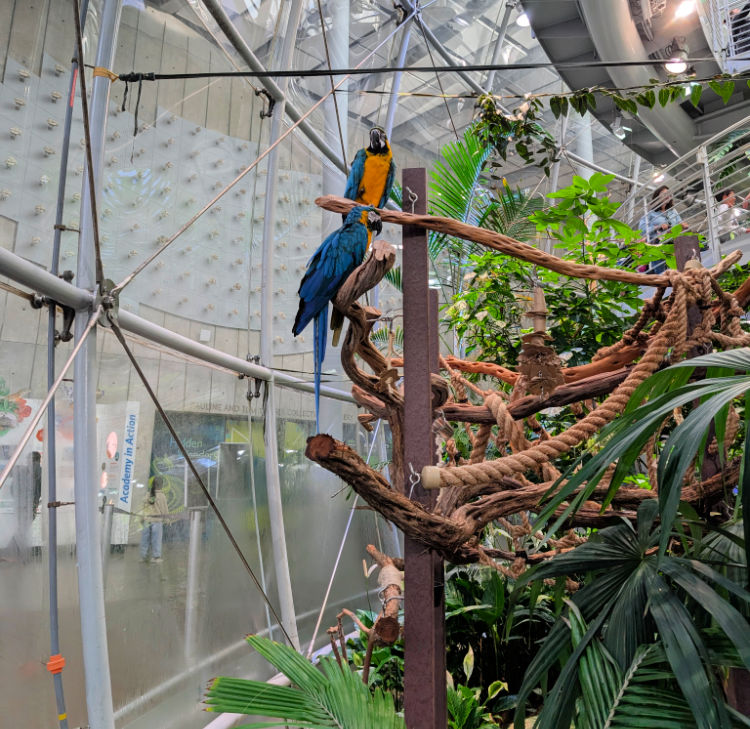 Two blue and yellow macaws in the Osher Rainforest were just hanging around and entertaining visitors.
Two blue and yellow macaws in the Osher Rainforest were just hanging around and entertaining visitors.I love to start my visit with a trip inside the Osher four-story rainforest. This large enclosure includes free-flying butterflies and birds that live in rainforests around the world.
Keep an eye out for the two blue and yellow macaws.
Other creatures you'll see in the rainforest include snakes and poisonous frogs. But don't worry - all the animals except the birds and butterflies are kept in their own separate homes.
Your visit starts on the ground level. You will slowly make your way up the circular walkways to the top of the rainforest. Each level teaches you about a specific rainforest's plants, animals and climates.
Once you reach the top level of the rainforest, you will be directed to the elevators and head down into the Steinhart Aquarium.
But first - check for butterflies to make sure you don't accidentally take any with you!
Steinhart Aquarium in San Francisco
The Steinhart Aquarium is another amazing experience inside this San Francisco science museum. Here are a few exhibits you don't want to miss:
- Coral Reefs of the World: There is an explosion of color here inside numerous tanks. It's a fun opportunity to see a variety of coral reefs from all over the world.
- Jellyfish Tank: I love that you can walk all the way around and watch the jellyfish float around. I love that the tank lights change color.
- Walk-Through Aquarium: Make sure to find the small section of aquarium you can walk underneath. It's a unique way to experience the fish in the tank!
- The Swamp: This is where Claude, the rare white alligator lives.
- California Coast: Here, you can learn all about our coast by checking out local fish and other animals.
The aquarium houses more than 40,000 live animals, including almost 9,000 species!
Morrison Planetarium
Another essential stop in the California Academy of Sciences is the Morrison Planetarium.
To reserve your tickets, scan the QR code in the lobby when you first arrive or the QR code at the entrance to the planetarium. Both will pull up that day's schedule, and you can select the show you want to see and then reserve your seat(s).
The shows are free and popular, so you want to reserve your tickets as soon as possible.
All shows are on a high-tech 75-foot diameter screen. It's one of the best planetarium shows I've ever seen.
Note: These shows are not recommended for kids 7 and under. They do not allow anyone under 4 into the shows at all.
Kimball Natural History Museum
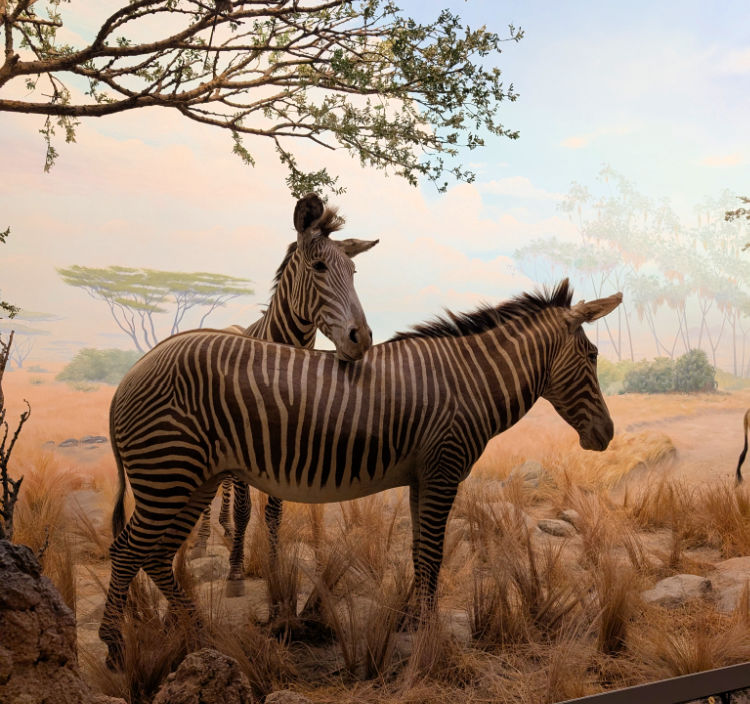 Two zebra are hanging out in the Kimball Natural History area of the California Academy of Sciences.
Two zebra are hanging out in the Kimball Natural History area of the California Academy of Sciences.The next major exhibit in the California Academy of Sciences is the Kimball Natural History Museum, which showcases more than 150 years of research by the museum.
Highlights include the Tusher African Hall, an 87-foot-long blue whale skeleton, and the Foucault pendulum (a brass ball that weighs 235 pounds and hangs on a 30-foot-long steel cable).
The Shake House
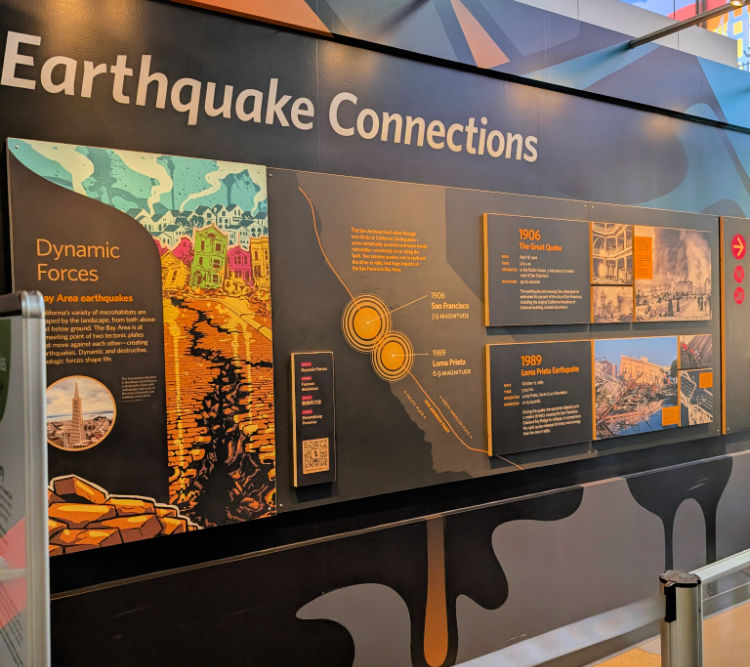 Before you enter The Shake House, you get the chance to read more about the two earthquakes you will feel once you enter.
Before you enter The Shake House, you get the chance to read more about the two earthquakes you will feel once you enter.Another really cool exhibit in the California Academy of Sciences is The Shake House.
Not only will you learn more about earthquakes, but you can also step into a shaking machine that simulates the 1989 earthquake and about 30 seconds of what the 1906 earthquake felt like.
If you step inside The Shake House and can't handle the shaking, there is a small doorway you can step into. You can watch the house shake from here, but you don't have to be part of the action.
I hope it's the only time you feel what it's like to be in an earthquake.
San Francisco Science Museum Living Roof
Remember to head up to the top floor to check out the living roof. It's green all year long but full of blossoms in the spring and early summer months. It also provides a habitat for local wildlife.
The museum's green roof is 2.3 acres large. It's home to more than 1.7 million plants.
The living roof offers insulation to the museum which reduces electrical costs. It collects excess storm water and creates more oxygen by transforming carbon dioxide.
A small lookout platform on the top of the building offers a great view of this part of the museum.
Insider's Secret: The tower at the de Young Museum, right across the street, offers a full view of the California Academy of Science's living roof. The tower is free to visit and open during de Young Museum hours.
VIP Tour - Behind the Scenes
If you are looking for a more personalized experience, the San Francisco science museum also offers a "behind the scenes" tour. You must also purchase an entrance ticket in addition to the VIP Tour ticket.
This is a small group tour. Each ticket also includes reserved seats to a show at the planetarium and express entry into the rainforest.
The VIP tour includes an hour-long tour during which you will learn more about this amazing museum. You will see items in their collection that are not on display to the general public, their private gem vault, and their living roof.
This tour includes steps and walking on some unpaved paths.
It's a great way to experience the museum slightly differently.
Academy of Sciences Nightlife
The California Academy of Sciences also hosts a 21+ Nightlife event. This event is held most Thursday nights from 6 pm to 10 pm. As you can imagine, this is another hot ticket and popular for locals and visitors.
I've had the chance to attend several times and they are really cool if you love science or learning about off-beat topics. Each Thursday night offers a different theme.
Past themes include Fungus Among Us, Year of the Dog, and Nightlife Spotlight (which is the best of what the museum has to offer).
You can explore the museum, listen to live music and mingle with other science lovers. You can also grab a drink or some food at the bar -- cash only. It starts at 6 pm and runs until 10 pm.
>> Find tickets in advance to the Academy's Nightlife event
What is the Dress Code for their Nightlife Event?
There is no strict dress code for the California Academy of Science's Nightlife event. Most people are in nice jeans and a dress shirt.
You will also find many people in business casual dress including dresses or nice pants.
It is chilly on this side of San Francisco most of the year, so bring a jacket or a light sweater for the event. You will need it as you enter and leave.
Discounts
Military Discounts
The California Academy of Sciences also offers discounts for active-duty military personnel. Present your current ID or proof of service (i.e., VA card or DD-214) at the ticket window when you arrive for $3 off daytime admission.
All Veterans, retired military personnel, and active-duty military personnel receive free daytime admission on Veterans Day and during Fleet Week in October.
These discounts only apply to military personnel and do not extend to your family members.
These tickets are only available at the ticketing window.
Sustainable Transportation Discount
You can get $3 off your ticket price if you walk, bike, or take public transit to the Academy.
These tickets are only available at the ticket window upon arrival.
Discount Passes
You can also save on your admission through these San Francisco discount passes. The passes offer admission to a variety of museums and attractions throughout SF, so your overall cost for each one is lower.
Two main San Francisco discount passes are honored at the California Academy of Sciences.
CityPass: This is the most popular pass. It offers admission to this San Francisco museum and a ticket for a 60-minute Bay Cruise. You can also select two more attractions to visit including the Aquarium of the Bay, the Exploratorium, the SF Zoo, SF Museum of Modern Art and the Walt Disney Museum. The discount will save you up to 46%.
>> Visit the CityPass site to learn more and pick up your pass today
Go City: The second discount pass is Go City. This one includes tickets for more than 25 attractions, tours, and museums. It allows you to mix and match options to select the right list of activities for your stay.
One of those options is this museum. Other options include the Aquarium of the Bay, the Hop On Hop Off Bus, the Exploratorium, the Zoo, and many others. It will save you up to 50% on buying the tickets individually.
This is perfect for those who love to fit in as much as possible in just a few days.
>> Visit their site to learn more about this discount pass
Who Should Visit the California Academy of Sciences?
Is the California Academy of Sciences Good for Adults?
Even though the California Academy of Sciences sounds like it's only for kids, it's perfect for visitors of all ages. Adults will love the four-story rainforest, aquarium, and earthquake simulator.
The Behind the Scenes tours are also very interesting as they dive into the science behind the scenes. It's great for kids, but I think it's even better for adults.
Adults will also love the planetarium shows. When you arrive, make sure to scan the QR code in the lobby to secure your tickets.
Is it Good for Toddlers?
Yes, this San Francisco science museum is perfect for toddlers. They love watching the rare white alligator, the penguins, and animals in the aquarium.
They also love the butterflies flying freely all around the 4-story rainforest.
They won't appreciate the Natural History Museum or the living roof, but there are plenty of other things for them to explore and enjoy.
With toddlers, I'd allow for just an hour or two unless they are really having an amazing time.
Toddlers are not able to see shows at the planetarium since they do not allow anyone under 4 to enter. These shows are best for those 7 and older.
Getting to the California Academy of Sciences
The San Francisco Science Museum is located on the eastern side of Golden Gate Park. There are several ways to get here including public transportation and driving.
If you are taking public transportation, your best options are the N-Judah or 5-Fulton. Both drop you off just a few blocks from the museum entrance.
How to Get Here from BART
It's really easy to get here from BART.
From the East Bay: If you are coming from the East Bay, take BART to the Montgomery Street Station. Here, you will transfer over to the N Light Rail Line of Muni. Take this all the way to the stop at 9th Avenue and Irving. This will drop you off south of Golden Gate Park in the Inner Sunset District.
After you exit the train, walk north toward the park. Once you enter the park, you will be on Martin Luther King Jr. Drive. Take this to Music Concourse Drive and take a right. You will see the museum on your right.
The walk takes about 10 to 15 minutes.
From the Peninsula or South Bay: Take BART to the Glen Park Station. Here you will transfer to the 44 Bus at Bosworth and Diamond Streets.
Exit on 9th Avenue and Lincoln Way. You will then enter the park, walk along Martin Luther King Drive and take a right at Music Concourse Drive. You will then see this San Francisco science museum on your right.
How to Get Here from Fisherman's Wharf
This route includes two buses that will take you within blocks of this San Francisco museum.
Bus #1: Pick up the 49 heading toward the Mission at the corner of North Point Street and Jones Street. Take this to the corner of Van Ness and McAllister.
Bus #2: You will then walk across McAllister Street to pick up the #5 Fulton (heading toward Ocean Beach) on the northwest corner of this intersection.
Take this second bus to the stop at Fulton and 10th Avenue. You will then enter the park and walk until you reach John F. Kennedy Drive. Take a left on JFK Drive and then a right when you reach Music Concourse Drive. At this point, you should see the museum about a block away. There should also be signs at this intersection.
The walk takes less than 10 minutes from the bus stop.
How to Get Here from Union Square
Head to the underground Powell Muni Station (at the end of the Cable Car turnaround).
Jump on the N Light Rail and take it to the stop at 9th and Irving. Walk north into the park. Stay on the street you entered on until you see Music Concourse Drive. Take a right here and you will see the museum on your right about a block away.
This walk takes about 10 to 15 minutes.
California Academy of Sciences Parking
You have a few parking options. Both options fill up early in the morning, so arrive as early as you can for parking.
Street Parking: Some of the streets in and around the museum are car-free. Street parking is available in certain places along Martin Luther King Jr. Drive and on Nancy Pelosi Drive.
All of these are an easy walk to the museum, but it can be hard to find a spot. Also, parking is only for 3 to 4 hours in most of these spots. Make sure to pay attention to the signs as they could decrease the amount you can park here at any time.
Parking Garage: There is also a large parking garage under the museum. You can enter in two locations:
- On Fulton at 10th Avenue
- Music Concourse at MLK, Jr. Drive.
There are a few wheelchair accessible spots in this garage that are right next to the elevator.
How Much Does it Cost to Park?
Parking on the street is free.
The following are the rates to park in the garage:
- $5.25 per hour on weekdays
- $6.25 an hour on weekends
- $29 for a full day on the weekdays, $33 for the full day on weekends
The garage opens at 7 am daily and closes at 7 pm Friday - Wednesday. It's open late Thursdays, when the Nightlife event takes place.
Note: The California Academy of Sciences does not own this lot, so if you have any complaints, take note of the information on the signs within the garage.
Food Options
Can you bring food inside?
They do not allow external food or beverages. If you have a special diet, call them ahead of time to discuss options.
What food do they have available?
There are two restaurants inside the California Academy of Sciences.
The Academy Café is a grab-and-go food option where you can grab a sandwich, sushi, salads, and other items off their menu. The food is local and offers seasonal ingredients. It's open during all museum hours, including Nightlife. It is open from 9 a.m. to 4 p.m. every day.
The Terrace Restaurant offers outdoor seating. It has a simple menu, but you can grab a seat to enjoy your meal along with a glass of wine or a craft beer. They open at 11 a.m. and close at around 3 p.m.
What are some other options nearby?
You will also find dozens of places with food nearby. Your best bet is to head to the Inner Sunset District. It's on the southern side of Golden Gate Park or about a 10-minute walk away.
The minute you enter this district, you enter its commercial area with all kinds of restaurants, bars, and other businesses.
This is the 9th and Irving area. Visit my Sunset District page for some of my favorites.
History of the California Academy of Sciences
This San Francisco science museum has a long history. It started in 1853 just three years after California became part of the United States. At that time, seven men put their work together to create the first collections for the museum.
Over the years, it grew and quickly became one of the best West Coast museums.
However, the 1906 Earthquake and Fire destroyed everything on display in San Francisco. It was fortunate that a good amount of the collection was on display in the Galapagos. Once these pieces returned to San Francisco, they formed the foundation for its new museum.
This San Francisco science museum found its home in Golden Gate Park in 1916 and began to blossom again.
The next big earthquake in 1989 again damaged this museum. Some of its exhibits had to be closed permanently, and others had to be reworked for the safety of its visitors.
At this point, they also decided to rework the entire museum and created plans for a much bigger and better one.
To keep this museum running, they relocated some of their exhibits downtown in 2003, when I first visited.
They then reopened this amazing new space in September 2008, where they plan to stay and invite visitors for decades to come!

Hi, I'm Jill!
Dreaming of a San Francisco vacation? As a proud local, I'm here to share my insider tips and personal experiences to help you make the most of this iconic city!
Comments? Questions? Suggestions?
I would love for you to join me in my private Facebook group!
It's a great place to interact with me and others who know the area well.
You can ask questions, get advice for your upcoming stay, and then share your photos and advice with others when you return home. It's a great community and the fastest way to get answers to those nagging questions about your visit!
